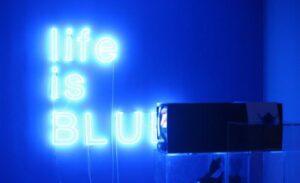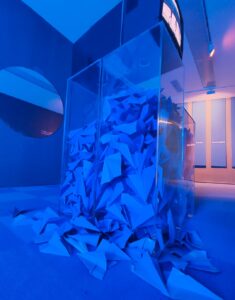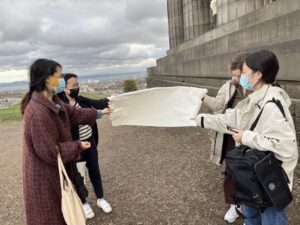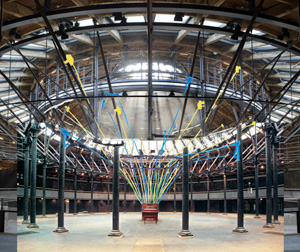Learning Sprint 3 | Beyond the Visual: Reflective Analysis
Embodied knowledge, while often denigrated and disavowed within the modern colonial episteme, confirms that Western scientistic validity comprises only one kind of knowing. Manifest through poetics, aesthetics, and other bodily attunements, sensuous knowledges open to alternative modes of relation. […] A sensory, embodied, affective, and imaginative relation to the world opens to a different kind of ethics and politics.
The human perceptual system is built up from the five senses of sight, hearing, smell, touch and taste, but today’s human society is dominated by the visual system. In our daily lives, we obtain a great deal of information through sight, to take the simplest example, when we walk into a building we have not yet set foot in, we often use a guidance system to confirm our direction, which usually consists of graphics and text, and through visuals to convey information to the visitor. When we want to cross a road, for example, we need to use our eyes to watch the traffic to ensure our safety, and we also need to visually observe the changes in the traffic lights to determine whether we should cross the intersection we want to cross. And although in the United Kingdom the changes in the traffic lights are accompanied by a ticking sound, in other countries that I have visited, including China, Japan, Korea, Thailand and Russia, the traffic lights only change in colour and iconography. In such a visually dominated society, it is inevitable that we lose sight of our other senses, but they are everywhere in our lives, and this Sprint allows us to leave visual behind for a moment and experience the world beyond the visual.
When asked to view Derek Jarman’s Blue on the course, my mind immediately went back to an artwork I had seen in an exhibition. What it had in common with Blue was the use of a very pure blue as the dominant colour – in both works, the viewer would be hard pressed to find any colour other than a large area of blue. But I think the use of the colour in Blue is more intended to deprive the viewer of the visual sensation. With only a full screen of blue to see, my body actively adjusted my sensory focus, shifting the visual to the auditory. I could hear the sound of the guitar and piano in the background, as well as the sound of the waves lapping at the beach and the chirping of the sea birds. The blue colour of the artwork I saw in the exhibition was a by-product of the author’s slogan ‘life is BLUE’. I associate this work of art with the high purity of blue in the film Blue, but all I can recall is the blue light and the piles of origami in the clear acrylic cabinet in the middle of the showroom. I have no recollection of what I heard, smelled or touched in the gallery that day. I believe the reason for this discrepancy is that the author’s focus was different. Blue was Derek Jarman’s last film before he died, and when he made it, he lost almost all of his vision, seeing only the vast expanse of blue, so he shifted the focus of his work to the sense of hearing. The artwork I saw in the exhibition, on the other hand, was made by an able-bodied man who used the colour blue to emphasise his idea that ‘life is BLUE’, and that the focus of his work was on the visual expression of life in relation to the colour blue.


For the Calton Hill Field Trip we used the sense of touch to record our group assignment. Our Basho noticed the malleability of paper and although it cannot completely replicate the texture of an object, it can perfectly record the grain of an object. So we took the paper with us and topographed many objects on Calton Hill, including rocks, ground, leaves, monuments and artworks in the gallery. One of my favourites was the process of topping the stone columns of the National Monument. The rough surface of the paper had an unexpected resemblance to the feel of the polished and weathered stone columns, and as I climbed up the National Monument to top the columns with paper, I found large and small cracks in the seemingly smooth stone columns and deep and shallow bumps on the corners. I liked the feeling of being able to touch the marks left by the ages, and I carefully recorded these marks on my paper with my fingernails.

The day we arrived at Calton Hill was a windy day, so we had an unexpected treat – paper that had been marked by the wind. We weren’t able to capture the wind that blew over the top of Calton Hill on 28 October, but it could leave a mark on our paper. We tried four people each holding a corner of the paper and letting the wind blow it around, or one person holding one end of the roll and letting the rest of the paper fly in the air like a fluttering flag. No one could have predicted the end result. In the process the strong wind even tore off a corner of our paper, but whatever we got out of it, it was a unique piece of art that nature had made for us.

This Sprint experience has brought to my attention many senses that I had not experienced before, and the way I access information changes when I actively leave the visual world behind. But I don’t think artworks that focus on senses other than sight negate the visual. Such as David Byrne’s interactive installation Playing The Building, which is housed in the disused lounge of a boat ferry waiting hall in lower Manhattan, where visitors are encouraged to play a small, dilapidated pipe organ. It is a typical piece of sound art, but the representation of the whole building as a musical instrument by the long lines connecting it can still be visually striking.

I believe that artworks and curatorial approaches today should also consider the multi-sensory forms of expression. After all, humans are creatures made up of five senses, and more senses can give people more experiences and feelings. How can we be sure that the world we see only through our eyes is real? By incorporating the multi-sensory expressions into artworks, artists can also broaden the path of artistic exploration and find a greater variety of artistic expressions. Today’s artworks are no longer confined to purely visual expressions; tactile art, sound art and other forms are gradually being created and developed, and if combined with more senses, more forms of artistic expression can be explored.




Recent comments